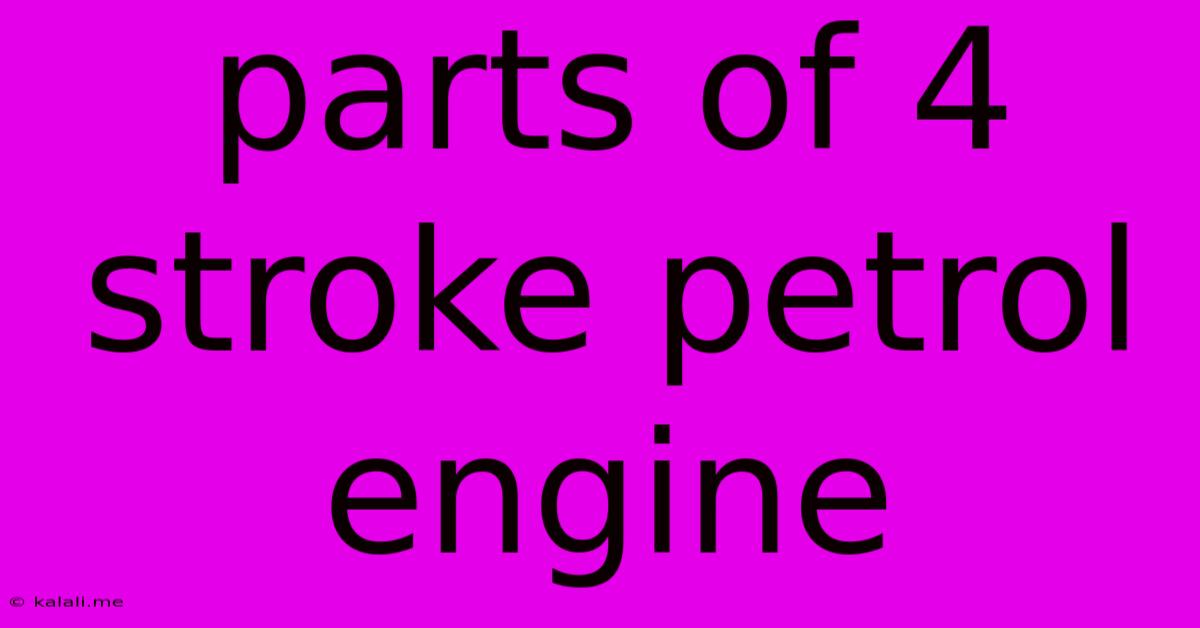Parts Of 4 Stroke Petrol Engine
Kalali
Jun 15, 2025 · 5 min read

Table of Contents
Decoding the Internal Combustion Engine: A Comprehensive Guide to the Parts of a 4-Stroke Petrol Engine
Understanding the inner workings of a four-stroke petrol engine is crucial for anyone interested in automobiles, mechanics, or engineering. This article provides a detailed breakdown of the key components, their functions, and how they work together to generate power. This guide will serve as a comprehensive resource, helping you understand everything from the piston's reciprocating motion to the intricate valve timing system.
What are the main parts of a 4-stroke petrol engine? A 4-stroke petrol engine is a marvel of engineering, converting the chemical energy stored in fuel into mechanical energy. Its operation hinges on the coordinated interplay of several essential components. We'll explore each part in detail, emphasizing their individual roles and their collaborative contribution to the engine's overall function.
1. The Crankshaft: The Engine's Heartbeat
The crankshaft is arguably the most crucial part of the engine. This rotating shaft converts the reciprocating (up and down) motion of the pistons into rotational motion, which ultimately drives the wheels of a vehicle or other machinery. It's a complex piece of forged steel, featuring journals (for bearing support), crankpins (connecting to the connecting rods), and counterweights (to balance the rotating assembly). The crankshaft's durability and precision are essential for engine longevity and smooth operation. Think of it as the engine's central nervous system, translating piston movement into usable energy.
2. The Pistons: The Power Generators
Pistons are cylindrical components that move up and down within the cylinders. They are driven by the expanding gases generated during combustion. The piston's crown (top) receives the force of the explosion, while the piston skirt (lower section) ensures a tight seal within the cylinder. Piston rings, fitted around the piston, prevent the escape of combustion gases and maintain lubrication. The piston pins connect the pistons to the connecting rods. The up and down motion of the pistons is the foundation of the four-stroke cycle.
3. The Connecting Rods: Translating Motion
These strong, slender rods act as a bridge between the pistons and the crankshaft. They transform the linear motion of the pistons into the rotational motion of the crankshaft. Connecting rods are typically made from high-strength steel alloys and are designed to withstand significant stress and pressure. Their design involves a large-end (connecting to the crankshaft) and a small-end (connecting to the piston pin).
4. The Cylinder Head: The Combustion Chamber
The cylinder head sits atop the engine block, housing the combustion chambers and containing crucial components like the valves, spark plugs, and camshafts. It forms a sealed chamber where fuel-air mixtures are ignited, producing the force that drives the pistons. The cylinder head's design is critical for efficient combustion, heat dissipation, and overall engine performance.
5. The Valves: Precisely Controlling Gas Flow
Intake and exhaust valves precisely control the flow of air and exhaust gases into and out of the cylinders. They open and close at precisely timed intervals, dictated by the camshaft. Intake valves allow the air-fuel mixture to enter the cylinder, while exhaust valves allow the spent gases to escape. The timing of these valves is crucial for efficient combustion and engine power output. Improper valve timing can lead to significant performance issues.
6. The Camshaft: Orchestrating Valve Timing
The camshaft is a rotating shaft with lobes that actuate the valves. It precisely controls the timing of valve opening and closing, ensuring optimal engine performance. Camshafts are usually driven by the crankshaft via gears or a chain. Different camshaft profiles can significantly alter engine characteristics, impacting power, torque, and fuel efficiency.
7. The Cylinder Block: The Engine's Foundation
The cylinder block forms the structural backbone of the engine. It houses the cylinders and provides support for other components like the crankshaft and connecting rods. It's typically made from cast iron or aluminum, chosen for their strength, durability, and heat resistance. The cylinder block’s design significantly impacts engine weight, durability, and performance characteristics.
8. The Spark Plugs: Igniting the Fuel-Air Mixture
Spark plugs are essential for igniting the compressed air-fuel mixture within the cylinder. A high-voltage spark jumps the gap in the spark plug, initiating combustion. The timing of the spark is crucial; improper timing can severely impact engine performance and fuel efficiency. Regular maintenance, including replacement, is necessary to ensure reliable ignition.
9. The Engine Block Gaskets: Maintaining Seals
Engine block gaskets seal the various engine components, preventing leaks of oil, coolant, and combustion gases. Various gaskets are used throughout the engine to ensure a leak-free and efficient operation. Their condition is critical for maintaining engine integrity and preventing catastrophic failures.
10. The Lubrication System: Protecting the Engine
A well-functioning lubrication system is crucial for minimizing friction and wear within the engine. Oil is pumped throughout the engine, lubricating moving parts such as the crankshaft, connecting rods, and pistons. This system greatly contributes to the engine's longevity and efficiency.
This comprehensive guide provides a fundamental understanding of the key parts of a 4-stroke petrol engine. Each component plays a vital role in the engine’s operation, and their proper functioning is crucial for optimal performance, reliability, and longevity. Understanding these components enables better appreciation of the complexity and ingenuity behind internal combustion technology.
Latest Posts
Latest Posts
-
Difference Between Cellulose Starch And Glycogen
Jun 16, 2025
-
Sample Cover Letter For Visa Application
Jun 16, 2025
-
Case Western Reserve University Average Sat
Jun 16, 2025
-
Which Memory Has Largest Storage Capacity
Jun 16, 2025
-
Where Is Air Pressure The Highest
Jun 16, 2025
Related Post
Thank you for visiting our website which covers about Parts Of 4 Stroke Petrol Engine . We hope the information provided has been useful to you. Feel free to contact us if you have any questions or need further assistance. See you next time and don't miss to bookmark.